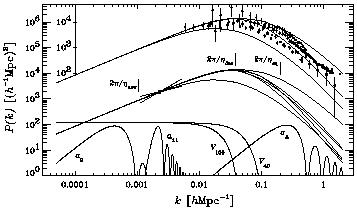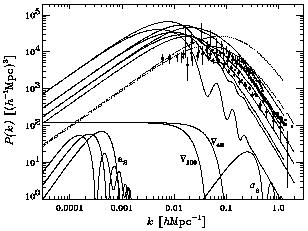

© CAMBRIDGE UNIVERSITY PRESS 1999
| |
1.7.3  CDM vs. CHDM -
Linear Theory
CDM vs. CHDM -
Linear Theory
These two CDM variants were identified as the best bets in the COBE
interpretation paper
(Wright et al. 1992,
largely based on
Holtzman 1989).
In order to discuss them in more detail, it will be best
to start by considering the rather complicated but very illuminating
Fig. 1.7, showing
COBE-normalized linear CHDM and
 CDM power spectra P
(k) compared with
four observational estimates of P (k).
(5)
Panel (a) shows the
CDM power spectra P
(k) compared with
four observational estimates of P (k).
(5)
Panel (a) shows the  = 1 CHDM
models, and Panel (b) shows the
= 1 CHDM
models, and Panel (b) shows the
 CDM models. The heavy solid
curves in Panel (a) are for h = 0.5 and
CDM models. The heavy solid
curves in Panel (a) are for h = 0.5 and
 b = 0.05. In the
middle section of
the figure, the highest of these curves represents the standard CDM
model, and the lower ones standard CHDM (N
b = 0.05. In the
middle section of
the figure, the highest of these curves represents the standard CDM
model, and the lower ones standard CHDM (N = 1) with
= 1) with

 = 0.2
(higher) and 0.3; the medium-weight solid curves represent the
corresponding CHDM models with two neutrinos equally sharing the same
total neutrino mass
(N
= 0.2
(higher) and 0.3; the medium-weight solid curves represent the
corresponding CHDM models with two neutrinos equally sharing the same
total neutrino mass
(N = 2). Note that
the N
= 2). Note that
the N = 2 CHDM power
spectra are significantly smaller than those for
N
= 2 CHDM power
spectra are significantly smaller than those for
N = 1 for k
= 1 for k
 0.04-0.4 h Mpc-1; this arises because for
N
0.04-0.4 h Mpc-1; this arises because for
N = 2 the neutrinos
weigh half as much and correspondingly free stream over a longer
distance. The result is that
N
= 2 the neutrinos
weigh half as much and correspondingly free stream over a longer
distance. The result is that
N = 2
COBE-normalized CHDM with
= 2
COBE-normalized CHDM with


 0.2 can
simultaneously fit the abundance and
correlations of clusters
(PHKC95, cf.
Borgani et al. 1996).
The light solid curve is CDM with
0.2 can
simultaneously fit the abundance and
correlations of clusters
(PHKC95, cf.
Borgani et al. 1996).
The light solid curve is CDM with
 =
=
 h = 0.2.
h = 0.2.

|

|
Figure 1.7. Fluctuation power
spectra for COBE-DMR-normalized models: Panel (a)
|
The ``bow'' superimposed on these curves represents the approximate
``pivot point'' (cf.
Gorski et al. 1994)
for COBE-normalized ``tilted''
models (i.e., with np  1), and the error bar there represents the
1
1), and the error bar there represents the
1 COBE normalization
uncertainty. The window functions for
various spherical harmonic coefficients al, bulk
velocities VR,
and
COBE normalization
uncertainty. The window functions for
various spherical harmonic coefficients al, bulk
velocities VR,
and  8 are shown in
the bottom part of this figure (see caption).
The bow lies above the a11 window because the
statistical weight of
the COBE data is greatest for angular wavenumber
8 are shown in
the bottom part of this figure (see caption).
The bow lies above the a11 window because the
statistical weight of
the COBE data is greatest for angular wavenumber 
 11
(cosmic variance is greater for lower
11
(cosmic variance is greater for lower  , and the ~ 7°
resolution of the COBE DMR makes the uncertainty increase for higher
, and the ~ 7°
resolution of the COBE DMR makes the uncertainty increase for higher
 ).
).
The upper section of Panel (a) reproduces the curves for ``standard''
CDM (SCDM, top),

 = 0.2 N
= 0.2 N = 1 CHDM, and
= 1 CHDM, and
 = 0.2 (light) P (k),
compared with several observational P (k) (see caption). Beware of
comparing apples to oranges to bananas! Note that the only one of
these observational data sets, that of Baugh & Efstathiou
(1993,
1994)
(squares) is the real-space P (k) reconstructed from the angular APM
data; that of
Peacock & Dodds
(1994)
(filled circles) is based on the
redshift-space data with a bias-dependent and
= 0.2 (light) P (k),
compared with several observational P (k) (see caption). Beware of
comparing apples to oranges to bananas! Note that the only one of
these observational data sets, that of Baugh & Efstathiou
(1993,
1994)
(squares) is the real-space P (k) reconstructed from the angular APM
data; that of
Peacock & Dodds
(1994)
(filled circles) is based on the
redshift-space data with a bias-dependent and
 -dependent
correction for redshift distortions and a model-dependent
(Peacock & Dodds
1996,
Smith et al. 1997)
correction for nonlinear evolution;
the others are in redshift space. Also, the observations are of
galaxies, which are likely to be a biased tracer of the dark matter,
while the theoretical spectra are for the dark matter itself.
Moreover, as will be discussed in more detail shortly, the real-space
linear P (k) are only a good approximation to the true real-space
P (k) for k
-dependent
correction for redshift distortions and a model-dependent
(Peacock & Dodds
1996,
Smith et al. 1997)
correction for nonlinear evolution;
the others are in redshift space. Also, the observations are of
galaxies, which are likely to be a biased tracer of the dark matter,
while the theoretical spectra are for the dark matter itself.
Moreover, as will be discussed in more detail shortly, the real-space
linear P (k) are only a good approximation to the true real-space
P (k) for k
 0.2 h
Mpc-1; nonlinear gravitational
clustering makes the actual P (k) rise about an order of magnitude
above the linear power spectrum for k
0.2 h
Mpc-1; nonlinear gravitational
clustering makes the actual P (k) rise about an order of magnitude
above the linear power spectrum for k  1 h Mpc-1. Thus
one can see that COBE-normalized SCDM predicts a considerably higher
P (k) than observations indicate. COBE-normalized
1 h Mpc-1. Thus
one can see that COBE-normalized SCDM predicts a considerably higher
P (k) than observations indicate. COBE-normalized
 = 0.2 CDM
predicts a power spectrum shape in better agreement with the data, but
with a normalization that is too low. But the P (k) for
= 0.2 CDM
predicts a power spectrum shape in better agreement with the data, but
with a normalization that is too low. But the P (k) for

 = 0.2 CHDM, especially with
N
= 0.2 CHDM, especially with
N = 2, is a pretty
good fit
both in shape and amplitude. The fact that the linear spectrum lies
lower than the data for large k is good news for this model, since,
as was just mentioned, nonlinear effects will increase the power there.
= 2, is a pretty
good fit
both in shape and amplitude. The fact that the linear spectrum lies
lower than the data for large k is good news for this model, since,
as was just mentioned, nonlinear effects will increase the power there.
The three heavy solid curves in Panel (b) represent the P (k) for
 CDM
with h = 0.8,
CDM
with h = 0.8,
 b = 0.02 for
b = 0.02 for
 0 = 0.1 (top, for k
= 0.001h Mpc-1), 0.2, and 0.3 (bottom). The lighter
curves are for the same
three values of
0 = 0.1 (top, for k
= 0.001h Mpc-1), 0.2, and 0.3 (bottom). The lighter
curves are for the same
three values of  0
plus 0.4 (bottom) with h = 0.5,
0
plus 0.4 (bottom) with h = 0.5,
 b = 0.05 (the large
wiggles in the latter reflect the effect of
the acoustic oscillations with a relatively large fraction of baryons).
Dotted curves are for SCDM models with the same pair of h values. The
observational P (k) are as in Panel (a).
b = 0.05 (the large
wiggles in the latter reflect the effect of
the acoustic oscillations with a relatively large fraction of baryons).
Dotted curves are for SCDM models with the same pair of h values. The
observational P (k) are as in Panel (a).
Note that the power increases at small k as
 0 decreases, with
opposite behavior at large k. Also, the COBE-normalized power spectra
are unaffected by the value of h for small k, but increase
with h
for larger k (the fact that the light h = 0.2 curve in
Panel (a) is
lower than SCDM reflects the same trend). The fact that the data points
lie lower than any of the
0 decreases, with
opposite behavior at large k. Also, the COBE-normalized power spectra
are unaffected by the value of h for small k, but increase
with h
for larger k (the fact that the light h = 0.2 curve in
Panel (a) is
lower than SCDM reflects the same trend). The fact that the data points
lie lower than any of the  CDM
models for k
CDM
models for k  0.02
is worrisome
for the success of
0.02
is worrisome
for the success of  CDM, but
it is too early to rule out these models on
this basis since various effects such as sparse sampling can lead the
current observational estimates of P (k) to be too low on large scales
(Efstathiou 1996).
A better measurement of P (k) on such large scales
k
CDM, but
it is too early to rule out these models on
this basis since various effects such as sparse sampling can lead the
current observational estimates of P (k) to be too low on large scales
(Efstathiou 1996).
A better measurement of P (k) on such large scales
k  10-2
h Mpc-1 will be one of the most important early
outputs of the next-generation very large redshift surveys: the 2°
field (2DF) survey at the Anglo-Australian Telescope, and the Sloan
Digital Sky Survey (SDSS) using a dedicated 2.5 m telescope at the Apache
Point Observatory in New Mexico. P (k) is much better determined for
larger k by the presently available data, and the fact that the linear
10-2
h Mpc-1 will be one of the most important early
outputs of the next-generation very large redshift surveys: the 2°
field (2DF) survey at the Anglo-Australian Telescope, and the Sloan
Digital Sky Survey (SDSS) using a dedicated 2.5 m telescope at the Apache
Point Observatory in New Mexico. P (k) is much better determined for
larger k by the presently available data, and the fact that the linear
 0 = 0.2 and 0.3
curves lie higher than many of the data points for
larger k means that these h = 0.8 models will lie far
above the data
when nonlinear effects are taken into account. This means that, unless
some physical process causes the galaxies to be much less clustered than
the dark matter (``anti-biasing''), such models could be acceptable only
with a considerable amount of tilt - but that can make the shape of the
spectrum fit more poorly.
0 = 0.2 and 0.3
curves lie higher than many of the data points for
larger k means that these h = 0.8 models will lie far
above the data
when nonlinear effects are taken into account. This means that, unless
some physical process causes the galaxies to be much less clustered than
the dark matter (``anti-biasing''), such models could be acceptable only
with a considerable amount of tilt - but that can make the shape of the
spectrum fit more poorly.
5 The normalization is
actually according to the two-year COBE data, which is about 10% higher
in amplitude than the final four-year COBE data
(Gorski et al. 1996),
but this relatively small difference will not be
important for our present purposes. Back.